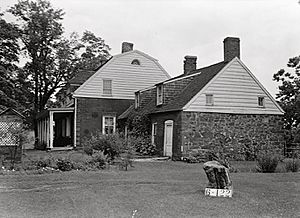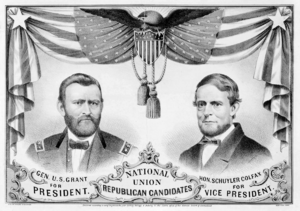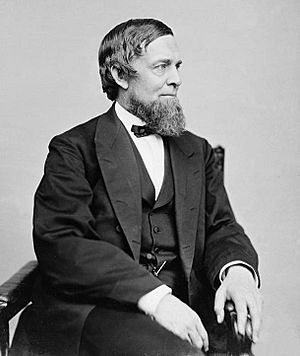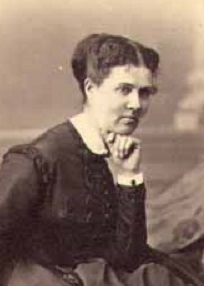Schuyler Colfax facts for kids
Quick facts for kids
Schuyler Colfax
|
|
|---|---|
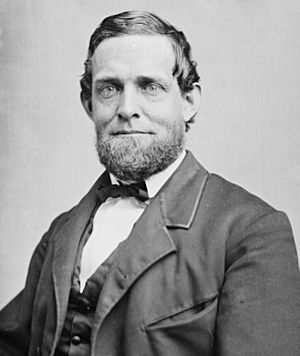
Colfax in 1869
|
|
| 17th Vice President of the United States | |
| In office March 4, 1869 – March 4, 1873 |
|
| President | Ulysses S. Grant |
| Preceded by | Andrew Johnson |
| Succeeded by | Henry Wilson |
| 25th Speaker of the United States House of Representatives | |
| In office December 7, 1863 – March 3, 1869 |
|
| Preceded by | Galusha A. Grow |
| Succeeded by | Theodore M. Pomeroy |
| Leader of the House Republican Conference |
|
| In office December 7, 1863 – March 3, 1869 |
|
| Preceded by | Galusha A. Grow |
| Succeeded by | Theodore M. Pomeroy |
| Member of the U.S. House of Representatives from Indiana's 9th district |
|
| In office March 4, 1855 – March 3, 1869 |
|
| Preceded by | Norman Eddy |
| Succeeded by | John P. C. Shanks |
| Personal details | |
| Born |
Schuyler Colfax Jr.
March 23, 1823 New York City, U.S. |
| Died | January 13, 1885 (aged 61) Mankato, Minnesota, U.S. |
| Resting place | South Bend City Cemetery, South Bend, Indiana, U.S. |
| Political party | Whig (before 1854) Republican (after 1854) |
| Other political affiliations |
Indiana People's Party (1854) |
| Spouses |
Evelyn Clark
(m. 1844; died 1863)Ellen Wade
(m. 1868) |
| Children | Schuyler Colfax III |
| Signature | |
Schuyler Colfax (March 23, 1823 – January 13, 1885) was an American journalist and politician. He served as the 17th Vice President of the United States from 1869 to 1873. Before that, he was the 25th Speaker of the United States House of Representatives from 1863 to 1869.
Colfax started his political career with the Whig Party. He then joined the short-lived People's Party of Indiana. Later, he became a member of the Republican Party. He represented Indiana in the United States House of Representatives from 1855 to 1869.
Colfax was known for being against slavery while he was in Congress. He also helped start the Republican Party. As Speaker, he worked to pass the Thirteenth Amendment to the United States Constitution. This amendment officially ended slavery in the United States.
In 1868, Colfax was chosen as Ulysses S. Grant's running mate for president. They easily won the election. As Vice President, Colfax had little direct power, which was common at the time. He continued to write for newspapers and give talks. In 1872, a government investigation linked Colfax to the Crédit Mobilier scandal. This scandal involved payments and discounted stock from a railroad company. Even though he strongly denied any wrongdoing, his public image was hurt.
Colfax left the vice presidency in March 1873 and never ran for office again. He then became a successful public speaker and business executive. He died from a heart attack in Mankato, Minnesota, on January 13, 1885. Colfax is one of only two people to have been both Speaker of the House and Vice President. The other was John Nance Garner.
Contents
Early Life and Family Background
Schuyler Colfax was born in New York City on March 23, 1823. His father, Schuyler Colfax Sr., was a bank teller. His mother was Hannah Stryker. Both of his parents had Dutch family backgrounds. His grandfather, William Colfax, was a soldier in George Washington's special guard during the American Revolution. William Colfax later became a general in the New Jersey Militia.
Schuyler Colfax Sr. died five months before Colfax was born. His sister also died shortly after he was born. After his father's death, Colfax's mother and grandmother ran a boarding house to support the family. Colfax went to school in New York City until he was 10. Then, due to money problems, he had to stop school. He took a job as a clerk in a store.
In 1836, his mother married George Matthews. The family moved to New Carlisle, Indiana. There, Matthews ran a store that also served as the village post office. Colfax loved reading newspapers and books. In 1841, the family moved to South Bend, Indiana. Matthews became the auditor for St. Joseph County, Indiana. He made Colfax his assistant, a job Colfax held for eight years.
Becoming a Newspaper Editor
In 1842, Colfax became the editor of the South Bend Free Press. This newspaper supported the Whig Party. The owner, John D. Defrees, moved to Indianapolis the next year. He bought the Indiana Journal and hired Colfax to report on the Indiana Senate. Colfax also wrote articles about Indiana politics for the New York Tribune. This led to a friendship with its editor, Horace Greeley.
In 1845, Colfax bought the South Bend Free Press. He changed its name to the St. Joseph Valley Register. He owned this newspaper for nine years. At first, it supported the Whigs. Later, it supported the new Republican Party.
Early Political Steps
While working as a journalist, Colfax also helped the Indiana Senate as an assistant clerk from 1842 to 1844. In 1843, he became a key member of a debating society in South Bend. This group discussed current events. Its success led to a mock state legislature. Members would debate and vote on bills, just like the real Indiana General Assembly. Colfax was also a prominent member of this group.
His success in these groups helped him get involved in politics. In 1848, he was chosen as a delegate to the 1848 Whig National Convention. He supported Zachary Taylor for president. Next, he was elected as a delegate to Indiana's state constitutional convention in 1849–1850. In 1851, Colfax ran for Congress as a Whig but lost. He lost partly because he voted against a rule that would stop free African Americans from moving to Indiana.
In 1852, Colfax was again a delegate to the 1852 Whig National Convention. He supported Winfield Scott for president. After Scott was chosen, Colfax actively campaigned for him. He gave speeches and wrote newspaper articles.
Serving in Congress (1855–1869)
In 1854, Colfax ran for Congress again. This time, he ran as a member of the Indiana People's Party. This party was against slavery and formed to oppose the Kansas–Nebraska Act. Colfax won and was reelected six times. He represented Indiana's 9th congressional district from March 4, 1855, to March 3, 1869. During his time in the House, Colfax became a leader. He chaired the United States House Committee on Post Office and Post Roads from 1859 to 1863.
Against Slavery
Colfax was part of the Radical Republicans in Congress. He was a strong opponent of slavery. In 1856, he gave a speech called "Kansas Code." In this speech, he attacked laws passed by the pro-slavery government in Kansas. This speech became a very popular document for the Republican campaign. As the 1860 presidential election neared, Colfax traveled a lot. He gave many speeches and helped unite different groups against slavery into one strong party.
During the Civil War
Before Abraham Lincoln became president, Indiana Republicans suggested Colfax for postmaster general. Lincoln wrote to Colfax, saying he was qualified. However, Lincoln had already promised that job to another person from Indiana.
At the start of the Civil War, Colfax visited General John C. Frémont in St. Louis, Missouri. Colfax was worried about Confederate troops in Kentucky and Missouri. He asked Frémont to send soldiers to stop them. Frémont said he did not have enough troops and had been asked to send some elsewhere. Colfax suggested Frémont refuse, but Frémont did not want to seem disobedient.
Later, General Ulysses S. Grant, under Frémont's command, took Paducah, Kentucky. This helped the Union. In November 1861, Lincoln removed Frémont from command. Grant then attacked Belmont. In 1862, Grant captured Confederate Forts Henry and Donelson. This forced the Confederates out of Kentucky.
Becoming Speaker of the House
In 1862, Colfax had a tough reelection campaign. Many people in Indiana were against the war. But he won by a small margin. The Speaker of the House, Galusha Grow, lost his election that year. When the 38th Congress met in December 1863, Colfax was elected Speaker. President Lincoln would have preferred someone less tied to the Radical Republicans. Colfax was elected Speaker three times:
- 38th Congress: Schuyler Colfax (R–IN) – 101 votes
- 39th Congress: Schuyler Colfax (R–IN) – 139 votes
- 40th Congress: Schuyler Colfax (R–IN) – 127 votes
As Speaker, Colfax helped create the Freedmen's Bureau. This agency helped formerly enslaved people. He also helped pass the Thirteenth Amendment to the United States Constitution. This amendment ended slavery. Usually, the Speaker only votes to break a tie. But Colfax voted for the Thirteenth Amendment, showing his strong support.
Reconstruction Efforts
In 1865, Colfax traveled across the western territories to California with author Samuel Bowles and Illinois Lieutenant Governor William Bross. They wrote a book called Our New West in 1869. It described their travels and talks with people like Brigham Young.
In 1867, Colfax spoke about the political situation in Washington. He was strongly against allowing former Confederates to hold office again. He supported Congress's plan for Reconstruction. He also supported the idea of impeaching President Andrew Johnson. Colfax believed Johnson was not following the Reconstruction laws.
The 1868 Election
At the 1868 Republican Convention, Ulysses S. Grant was nominated for president. Colfax was chosen as his running mate for vice president. Republicans liked Colfax because he was friendly, loyal to the party, and had strong views on Reconstruction. They called him "Smiler Colfax." Grant and Colfax won the election. Colfax became the 17th Vice President of the United States.
On March 3, 1869, the day before he became Vice President, Colfax resigned as Speaker. The House then quickly elected Theodore Pomeroy as Speaker for one day. Pomeroy's time as Speaker is the shortest in U.S. history.
Vice Presidency (1869–1873)
Colfax became Vice President on March 4, 1869. He served until March 4, 1873. Grant was 46 and Colfax was 45 when they took office. They were the youngest presidential and vice presidential team until Bill Clinton and Al Gore in 1993.
Colfax and John Nance Garner are the only two Vice Presidents who were also Speaker of the House before becoming Vice President. Since the Vice President leads the Senate, they are the only two people to have led both houses of Congress.
Supporting Italian Unity
In January 1871, Colfax wrote a letter published in the New York Times. He celebrated King Victor Emmanuel II's success in uniting Italy and setting up a new government in Rome. Colfax hoped Italy would form a government that protected religious freedom and the rights of all people.
The 1872 Election and Its Impact
Before the 1872 Presidential election, Colfax thought Grant would only serve one term. In 1870, Colfax said he would not run for office in 1872. He hoped this would encourage Republicans to support him for president. However, Grant decided to run for a second term. Also, a new group, the Liberal Republicans, showed interest in Colfax as a possible candidate. This made Grant and the regular Republicans less supportive of Colfax.
Colfax changed his mind and decided to run for Vice President again. But his earlier statement had created competition. Senator Henry Wilson won the Republican nomination for Vice President instead of Colfax. Grant won the election, and Wilson became the 18th Vice President.
Life After the Vice Presidency (1873–1885)
Public Speaker and Business Leader
After leaving office in March 1873, Colfax started to rebuild his public image. He became a very popular public speaker. His most requested speech was about the life of Abraham Lincoln. Many people wanted to hear more about Lincoln, and Colfax, who knew him personally, was a popular speaker. He gave his Lincoln speech hundreds of times.
In 1875, he became a vice president at the Indiana Reaper and Iron Company. He was often asked to run for public office again, but he always said no. In 1882, he wrote a letter to the South Bend Tribune. He said he was thankful for his friends' support. But he was happy with his 20 years of public service during "the stormiest years of our nation's history." He said he enjoyed being a private citizen and would not run for any office in the future.
His Death and Burial
On January 13, 1885, Colfax was traveling to give a speech in Iowa. He walked about one kilometer in very cold weather (around -30°F) to change trains in Mankato, Minnesota. Five minutes after arriving at the station, he died of a heart attack. The extreme cold and exhaustion caused it.
He was buried at City Cemetery in South Bend, Indiana. A historical marker in Mankato's Washington Park shows where he died.
Personal Life and Family
Colfax was married twice:
- On October 10, 1844, he married his childhood friend Evelyn Clark. She died in 1863, and they did not have any children.
- On November 18, 1868, he married Ellen (Ella) M. Wade (1836–1911). She was a niece of Senator Benjamin Wade. They had one son, Schuyler Colfax III (1870–1925). This son later became the mayor of South Bend, Indiana, from 1898 to 1901. He was 28 when he took office, making him the youngest mayor in the city's history.
Colfax was a member of the Independent Order of Odd Fellows (IOOF). In 1851, the IOOF approved a special degree for women called the Rebekah Degree. Colfax was recognized as its creator. In 1854, he became an honorary member of the Beta Theta Pi fraternity at DePauw University.
His Legacy and Recognition
Colfax's 20 years of public service ended with the Crédit Mobilier scandal in 1873. He never returned to politics. He believed it was best to stay out of politics once he left office. Also, he was happy with his life as a private citizen. Because he was a successful public speaker, his reputation improved somewhat.
A ship named after Colfax was built in 1871 for the United States Revenue Cutter Service. It served along the Atlantic Coast. Many towns in the U.S. are named after him, including places in California, North Carolina, Illinois, Washington, Wisconsin, Indiana, Iowa, Texas, and Louisiana. Schuyler, Nebraska, and Colfax County, New Mexico, are also named in his honor.
Colfax Avenue in South Bend, Indiana, is named after him. His adult home was on that street. There are also Colfax Avenues in Mishawaka, Indiana, and in Staten Island, New York City. A very long commercial street in Colorado, Colfax Avenue, is also named after him. Other streets and places across the U.S. bear his name.
Colfax School in South Bend, Indiana, opened in 1898. It was near Colfax's home. The building is still there today as the Colfax Cultural Center. There is also a Colfax Elementary School in Pittsburgh, Pennsylvania. The Schuyler-Colfax House in Wayne, New Jersey, built by his ancestors, was added to the National Register of Historic Places in 1973.
A monument to Schuyler Colfax stands in Colfax, California. There is also a statue of him in Indianapolis, Indiana.
Images for kids
See also
 In Spanish: Schuyler Colfax para niños
In Spanish: Schuyler Colfax para niños


